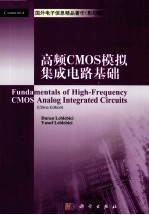图书介绍
高频CMOS模拟集成电路基础 英文版pdf电子书版本下载

- DuranLeblebici著 著
- 出版社: 北京:科学出版社
- ISBN:9787030315199
- 出版时间:2011
- 标注页数:302页
- 文件大小:15MB
- 文件页数:316页
- 主题词:CMOS电路: 模拟集成电路-英文
PDF下载
下载说明
高频CMOS模拟集成电路基础 英文版PDF格式电子书版下载
下载的文件为RAR压缩包。需要使用解压软件进行解压得到PDF格式图书。建议使用BT下载工具Free Download Manager进行下载,简称FDM(免费,没有广告,支持多平台)。本站资源全部打包为BT种子。所以需要使用专业的BT下载软件进行下载。如 BitComet qBittorrent uTorrent等BT下载工具。迅雷目前由于本站不是热门资源。不推荐使用!后期资源热门了。安装了迅雷也可以迅雷进行下载!
(文件页数 要大于 标注页数,上中下等多册电子书除外)
注意:本站所有压缩包均有解压码: 点击下载压缩包解压工具
图书目录
1 Components of analog CMOS ICs 1
1.1 MOS transistors 1
1.1.1 Current-voltage relations of MOS transistors 3
1.1.1.1 The basic current-voltage relations without velocity saturation 4
1.1.1.2 Current-voltage relations under velocity saturation 11
1.1.1.3 The sub-threshold regime 15
1.1.2 Determination of model parameters and related secondary effects 19
1.1.2.1 Mobility 20
1.1.2.2 Gate capacitance 20
1.1.2.3 Threshold voltage 21
1.1.2.4 Channel length modulation factor 23
1.1.2.5 Gate length(L)and gate width(W) 24
1.1.3 Parasitics of MOS transistors 25
1.1.3.1 Parasitic capacitances 26
1.1.3.2 The high-frequency figure of merit 30
1.1.3.3 The parasitic resistances 31
1.2 Passive on-chip components 36
1.2.1 On-chip resistors 36
1.2.2 On-chip capacitors 38
1.2.2.1 Passive on-chip capacitors 38
1.2.2.2 Varactors 40
1.2.3 On-chip inductors 43
2 Basic MOS amplifiers:DC and low-frequency behavior 49
2.1 Common source(grounded source)amplifier 49
2.1.1 Biasing 53
2.1.2 The small-signal equivalent circuit 54
2.2 Active transistor loaded MOS amplifier(CMOS inverter as analog amplifier) 63
2.3 Common-gate(grounded-gate)amplifier 68
2.4 Common-drain amplifier(source follower) 70
2.5 The"long tailed pair" 75
2.5.1 The large signal behavior of the long tailed pair 84
2.5.2 Common-mode feedback 88
3 High-frequency behavior of basic amplifiers 95
3.1 High-frequency behavior of a common-source amplifier 97
3.1.1 The R-C load case 99
3.2 The source follower amplifier at radio frequencies 103
3.3 The common-gate amplifier at high frequencies 110
3.4 The"cascode"amplifier 114
3.5 The CMOS inverter as a transimpedance amplifier 118
3.6 MOS transistor with source degeneration at high frequencies 126
3.7 High-frequency behavior of differential amplifiers 129
3.7.1 The R-C loaded long tailed pair 129
3.7.2 The fully differential,current-mirror loaded amplifier 132
3.7.3 Frequency response of a single-ended output long tailed pair 136
3.7.4 On the input and output admittances of the long tailed pair 141
3.8 Gain enhancement techniques for high-frequency amplifiers 143
3.8.1 "Additive"approach:distributed amplifiers 144
3.8.2 Cascading strategies for basic gain stages 146
3.8.3 An example:the"Cherry-Hooper"amplifier 148
4 Frequency-selective RF circuits 155
4.1 Resonance circuits 156
4.1.1 The parallel resonance circuit 156
4.1.1.1 The quality factor of a resonance circuit 160
4.1.1.2 The quality factor from a different point of view 163
4.1.1.3 The"Q enhancement" 164
4.1.1.4 Bandwidth of a parallel resonance circuit 168
4.1.1.5 Currents of L and C branches of a parallel resonance circuit 169
4.1.2 The series resonance circuit 170
4.1.2.1 Component voltages in a series resonance circuit 172
4.2 Tuned amplifiers 172
4.2.1 The common-source tuned amplifier 173
4.2.2 The tuned cascode amplifier 179
4.3 Cascaded tuned stages and the staggered tuning 181
4.4 Amplifiers loaded with coupled resonance circuits 189
4.4.1 Magnetic coupling 189
4.4.2 Capacitive coupling 194
4.5 The gyrator:a valuable tool to realize high-value on-chip inductances 194
4.5.1 Parasitics of a non-ideal gyrator 197
4.5.2 Dynamic range of a gyrator-based inductor 201
4.6 The low-noise amplifier(LNA) 202
4.6.1 Input impedance matching 203
4.6.2 Basic circuits suitable for LNAs 207
4.6.3 Noise in amplifiers 210
4.6.3.1 Thermal noise of a resistor 212
4.6.3.2 Thermal noise of a MOS transistor 213
4.6.4 Noise in LNAs 224
4.6.5 The differential LNA 234
5 L-C oscillators 237
5.1 The negative resistance approach to L-C oscillators 237
5.2 The feedback approach to L-C oscillators 245
5.3 Frequency stability of L-C oscillators 249
5.3.1 Crystal oscillators 251
5.3.2 The phase-lock technique 253
5.3.3 Phase noise in oscillators 255
6 Analog-digital interface and system-level design considerations 259
6.1 General observations 259
6.2 Discrete-time sampling 263
6.3 Influence of sampling clock jitter 265
6.4 Quantization noise 267
6.5 Converter specifications 268
6.5.1 Static specifications 269
6.5.2 Frequency-domain dynamic specifications 273
6.6 Additional observations on noise in high-frequency ICs 275
Appendix A Mobility degradation due to the transversal field 277
Appendix B Characteristic curves and parameters of AMS 0.35 micron NMOS and PMOS transistors 279
Appendix C BSIM3-v3 parameters of AMS 0.35 micron NMOS and PMOS transistors 281
Appendix D Current sources and current mirrors 287
D.1 DC current sources 287
D.2 Frequency characteristics of basic current mirrors 289
D.2.1 Frequency characteristics for normal saturation 291
D.2.2 Frequency characteristics under velocity saturation 292
References 293
Index 297